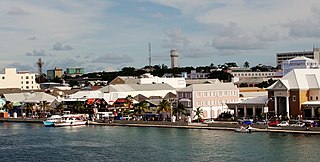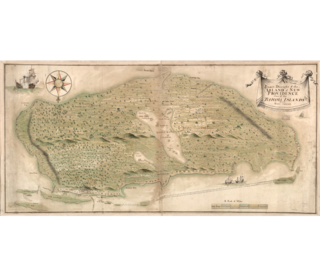Related Research Articles

Nassau is the capital and largest city of The Bahamas. It is located on the island of New Providence, which had a population of 246,329 in 2010, or just over 70% of the entire population of The Bahamas. As of April 2023, the preliminary results of the 2022 census of the Bahamas reported a population of 296,522 for New Providence, 74.26% of the country's population. Nassau is commonly defined as a primate city, dwarfing all other towns in the country. It is the centre of commerce, education, law, administration, and media of the country.

The earliest arrival of people in the islands now known as The Bahamas was in the first millennium AD. The first inhabitants of the islands were the Lucayans, an Arawakan language-speaking Taino people, who arrived between about 500 and 800 AD from other islands of the Caribbean.

New Providence is the most populous island in the Bahamas, containing more than 70% of the total population. It is the location of the national capital city of Nassau, whose boundaries are coincident with the island; it had a population of 246,329 at the 2010 Census; the latest estimate (2016) is 274,400.
Benjamin Hornigold (1680–1719) was an English pirate who operated during the tail end of the Golden Age of Piracy.

Woodes Rogers was an English sea captain, privateer, slave trader and, from 1718, the first Royal Governor of the Bahamas. He is remembered as the captain of the vessel that rescued marooned Alexander Selkirk, whose plight is generally believed to have inspired Daniel Defoe's Robinson Crusoe.

The Golden Age of Piracy is a common designation for the period between the 1650s and the 1730s, when maritime piracy was a significant factor in the histories of the North Atlantic and Indian Oceans.

Charles Vane was an English pirate who operated in the Bahamas during the end of the Golden Age of Piracy.
Henry Jennings was an English privateer-turned-pirate. Jennings' first recorded act of piracy took place in early 1716 when, with three vessels and 150–300 men, Jennings' fleet ambushed the Spanish salvage camp from the 1715 Treasure Fleet. After the Florida raid, Jennings and his crew also linked up with Benjamin Hornigold's "three sets of pirates" from New Providence Island.

The Raid on Nassau was a Spanish military expedition that took place in February 1720 during the War of the Quadruple Alliance wherein Spanish forces assaulted the British settlement of Nassau in an attempt to seize the island of New Providence. Although the Spanish managed to raid outlying posts, the assault on Nassau itself was repelled and the invasion was a failure.

The Republic of Pirates was the base and stronghold of a loose confederacy run by privateers-turned-pirates in Nassau on New Providence island in the Bahamas during the Golden Age of Piracy for about twelve years from 1706 until 1718. While it was not a republic in a formal sense, it was governed by an informal pirate code, which dictated that the crews of the Republic would vote on the leadership of their ships and treat other pirate crews with civility. The term comes from Colin Woodard's book of the same name.

The Flying Gang was an 18th-century group of pirates who established themselves in Nassau, New Providence in the Bahamas after the destruction of Port Royal in Jamaica. The gang consisted of the most notorious and cunning pirates of the time, and they terrorized and pillaged the Caribbean until the Royal Navy and infighting brought them to justice. They achieved great fame and wealth by raiding salvagers attempting to recover gold from the sunken Spanish treasure fleet. They established their own codes and governed themselves independent from any of the colonial powers of the time. Nassau was deemed the Republic of Pirates as it attracted many former privateers looking for work to its shores. The Governor of Bermuda stated that there were over 1,000 pirates in Nassau at that time and that they outnumbered the mere hundred inhabitants in the town.
Josiah Burgess (1689–1719) was an English pirate active in the Caribbean. He is best known as one of the heads of New Providence’s “Flying Gang.”
Nicholas Woodall was a pirate and smuggler active in the Caribbean. He is best known for his involvement with Charles Vane and Benjamin Hornigold.
Daniel Stillwell was a minor pirate in the Caribbean, best known for his association with Benjamin Hornigold.
John Cockram was a pirate, trader, and pirate hunter in the Caribbean, best known for his association with Admiral Benjamin Hornigold.
Paulsgrave Williams, first name occasionally Paul, Palsgrave, or Palgrave, was a pirate who was active 1716–1723 and sailed in the Caribbean, American eastern seaboard, and off West Africa. He is best known for sailing alongside Samuel Bellamy.
William Fox was a pirate active in the Caribbean and off the African coast. He was indirectly associated with a number of more prominent pirates such as Bartholomew Roberts, Edward England, and Richard Taylor.
Turn Joe was an Irish pirate and privateer who left English service and sailed for Spain instead as a guarda costa privateer in the Caribbean.
Thomas Barrow was a pirate active in the Caribbean. He is best known for proclaiming himself Governor of New Providence.
Phineas Bunce was a pirate active in the Caribbean. He was pardoned for piracy but reverted to it immediately afterwards and was killed by a Spanish pirate hunter.
References
- 1 2 3 Woodard, Colin (2008). The Republic of Pirates: Being the True and Surprising Story of the Caribbean Pirates and the Man Who Brought Them Down. Orlando FL: Houghton Mifflin Harcourt. ISBN 978-0547415758.
- ↑ Fictum, David (26 July 2015). ""The Strongest Man Carries the Day," Life in New Providence, 1716-1717". Colonies, Ships, and Pirates. Retrieved 5 August 2017.
